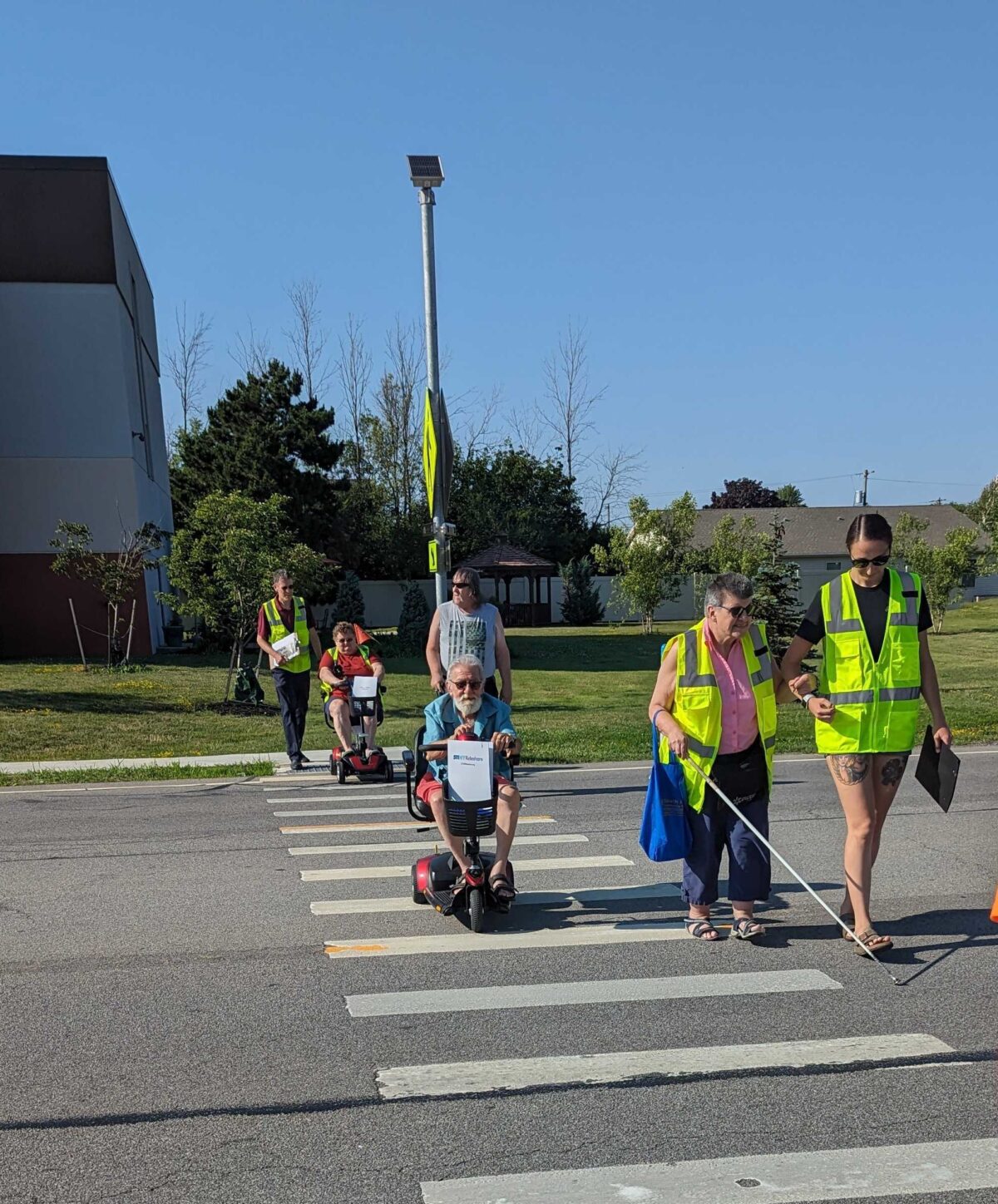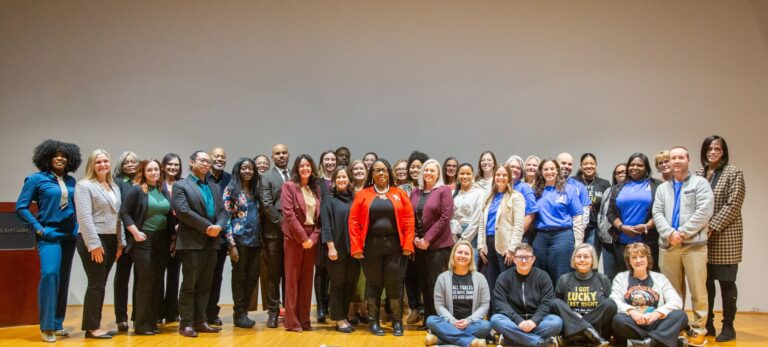Pictured: GOBike volunteers leading residents on a walk audit
This story first appeared in our 2023 annual report.
How can we create neighborhoods that welcome residents of all ages, where growing older isn’t a barrier to living well? What does an age-friendly environment look like in our hospitals and medical facilities?
At the Health Foundation, we champion initiatives that support healthy aging by centering the needs and wishes of older adults. In our strategic plan, we formalized our commitment in Midterm Goal 5: “Communities and health systems are working collaboratively to become age-friendly.” We’ve worked to bring the age-friendly approach to communities in several different ways—from hospitals to neighborhoods.
Our age-friendly work has included the funding of county-driven Age-Friendly Centers of Excellence and an evidence-based approach to geriatric care called Age-Friendly Health Systems. In 2022, we began funding Age-Friendly: Go Local, a program that offers financial support to organizations working to design age-friendly communities, with a particular emphasis on the safety and well-being of older adults.
Why a holistic approach to age-friendly work? Research has shown that creating livable communities benefits not only older adults and people with disabilities, but everyone else, too.
The passion and dedication of two grantee-partners—GObike Buffalo and Cayuga Health System—bring to life the strength and vitality of an age-friendly approach.
GObike Buffalo: Enhancing safety for older adults
“It’s about getting where you need to go, regardless of mode and regardless of age and mobility.”
~ Justin Booth, Executive Director, GObike Buffalo
Our Mother of Good Counsel is a 43-unit apartment complex whose residents are older adults on fixed incomes. Located in Blasdell, a village within the Town of Hamburg, the building is situated on Lake Avenue between two main thoroughfares and less than a mile away from a busy thruway exit.
In recent years, pedestrians have been hit by passing cars while trying to cross the street in front of the apartments. After a fatality in 2019, the Town of Hamburg installed a pedestrian crossing signal and a yellow pedestrian crossing sign. Unfortunately, this safety step failed to prevent another tragedy: the death of a beloved resident in 2023. Despite a reduced speed limit of 35 miles per hour, most motorists fail to slow down when a person is entering the crosswalk.
To find a solution for these Blasdell residents, the Town of Hamburg partnered with GObike Buffalo on a Health Foundation-funded project, which became part of the Hamburg Active Mobility Action Plan. The addition of the Blasdell project to the plan was made possible by funding from the Health Foundation, in partnership with the New York Academy of Medicine, through Age-Friendly: Go Local. This unique hyperlocal program focuses on initiatives built on the principles of age-friendliness, livability, and equity to improve the lives and health of residents.
For Justin Booth, Executive Director of GObike Buffalo, and Randy Hoak, Hamburg Town Supervisor, the Go Local project is an opportunity to view the needs of the Blasdell community with a wide-angle lens. They’re inspired to explore ways to improve overall livability for the surrounding area—beyond fixing one treacherous crosswalk. GObike volunteers have conducted walk audits to study traffic patterns, driving habits, cracked sidewalks, commercial activity, and the demographic makeup of the area. “We wanted to look at how we can connect communities and give people safe opportunities to move about those communities,” Justin explains.
Justin and Randy have also met with Our Mother of Good Counsel residents to listen to their stories and concerns. “We’re exploring all the options,” Randy says.
Once the Hamburg Active Mobility Action Plan is finalized, it will be presented to Erie County. Randy hopes to secure a county grant that will allow the Town of Hamburg to implement the entire plan, including the age-friendly component inspired by the lived experiences of Our Mother of Good Counsel residents.
Blasdell’s Go Local project is an example of how inclusive design solutions can improve the quality of life for older members of a community—and everyone else.
Cayuga Health System: Small steps inspire big changes
“The changes we’ve made haven’t just benefited the patients. Our care team has benefited, too.”
~ Emily Mallar, Senior Director for Care Transitions, Cayuga Health System
The Health Foundation was the lead funder of the Age-Friendly Health Systems (AFHS) New York State Action Community led by the Healthcare Association of New York State and based on the model developed by The John A. Hartford Foundation.
The framework uses a set of four evidence-based elements to organize the care of older adults, known as the 4Ms: What Matters (understanding what’s important to older adults), Medication (knowing if medications are unnecessary or potentially harmful), Mobility (creating individual mobility plans), and Mentation (addressing conditions like dementia, delirium, and depression). When these 4Ms are implemented together, older adults experience stronger health outcomes and a better quality of life.
According to Emily Mallar, Senior Director for Care Transitions at Cayuga Health System, participating in the New York State Action Community with the Health Foundation’s support enabled their team to accomplish the following after an inpatient pilot project launched in October 2023:
What Matters. Because Cayuga Health’s recreational therapists routinely ask questions, they were already quite comfortable with getting patients to share goals and concerns. However, the therapists’ documentation wasn’t part of a patient’s care file. In formalizing a What Matters approach, these observations were integrated into the care files, daily case conferences, and overall care plans. The additional insights have enabled the rest of the care team to grasp a more holistic picture of each patient’s health. And the recreational therapists now feel like an integral part of the team.
Medication. Despite being well-versed in a traditional approach, one longtime provider was quick to adopt the new documentation standards for medication review. The new process included an IT enhancement to support documentation and tracking.
Mobility. “Mobility was the area where we were already doing well,” Emily explains. The Cayuga Health team had previously rolled out the Activity Measure for Post Acute Care (AM-PAC) mobility program before applying for AFHS.
Mentation. Previously, whenever a shift ended, it was customary for the outgoing nurse to record observations and sign out. The incoming nurse would then see the patient and record their observations. To achieve a more aligned approach, the outgoing nurse and the incoming nurse now observe the patient together during the bedside handoff. This collaborative approach has strengthened the validity of each assessment.
The AFHS approach has broken down the silos within the Cayuga Health team and inspired dynamic team meetings. Now every member shares their input on behalf of a patient’s care.
A Master Plan for Aging
We believe age-friendly solutions are achievable, but success requires an intentional, committed approach. Thanks in part to our advocacy, New York State is in the development stage of an important effort that builds on previous age-friendly work: the Master Plan for Aging. We look forward to continuing to help shape this plan with the goal of creating a New York State where older adults—and all residents—have what they need to live healthy lives.



